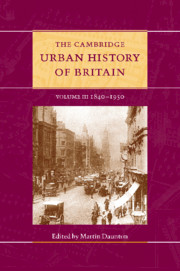Book contents
- Frontmatter
- 1 Introduction
- Part I Circulation
- Part II Governance
- Part III Construction
- Part IV Getting and spending
- Part V Images
- 24 The representation of the city in the visual arts
- 25 Epilogue
- Select bibliography
- Index
- Plates 1-7
- Plates 8-14
- Plates 15-20
- Plates 21-27
- Plates 28-34
- Plates 35-41
- Plates 42-48>
- Plates 49-53
25 - Epilogue
from Part V - Images
Published online by Cambridge University Press: 28 March 2008
- Frontmatter
- 1 Introduction
- Part I Circulation
- Part II Governance
- Part III Construction
- Part IV Getting and spending
- Part V Images
- 24 The representation of the city in the visual arts
- 25 Epilogue
- Select bibliography
- Index
- Plates 1-7
- Plates 8-14
- Plates 15-20
- Plates 21-27
- Plates 28-34
- Plates 35-41
- Plates 42-48>
- Plates 49-53
Summary
The third volume of the Cambridge Urban History comes to a close around 1950. It has explained how crisis and rupture in the second quarter of the nineteenth century were resolved in the later nineteenth century, through the creation of voluntary associations and an active municipal culture to deal with problems of ‘free riders’ and urban diseconomies, and to provide large-scale investment in the urban infrastructure. During much of this period, cities had powerful external economies, and allowed firms to operate with relatively weak internal systems of management. They accumulated considerable amounts of ‘social capital’ – webs of interconnections and sociability – which contributed to economic efficiency, social stability and political effectiveness. But the importance of cities slowly started to decline in the twentieth century. The power of the central state increased, taking an ever greater role in providing welfare and in offering financial assistance for local services. Municipal enterprises were nationalised, and local democratic control surrendered. Industrial concerns developed internal management systems, and were more concerned with national politics than with the municipality, with institutional investors in London than with networks of local reputation.
- Type
- Chapter
- Information
- The Cambridge Urban History of Britain , pp. 833 - 840Publisher: Cambridge University PressPrint publication year: 2001
- 1
- Cited by

